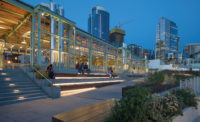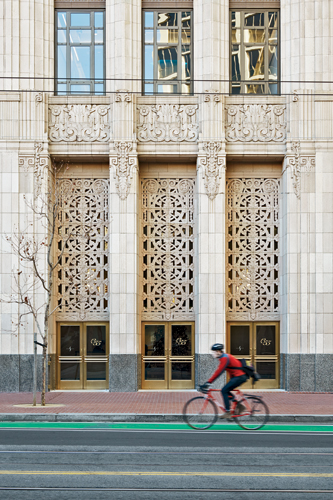Market Square
Urban Game Changer: Having attracted Twitter, upscale retail, and a food emporium as key tenants, a renovated Art Deco building is kick-starting the transformation of a once-seedy part of San Francisco.


















With a prime location near San Francisco's Civic Center and downtown shopping corridor, one of the city's few subway stops, and wide brick sidewalks fit for throngs of pedestrians, Mid-Market has had all the makings of a sought-after neighborhood. Though it was a thriving theater district in the early 20th century, this mile-long stretch of Market Street never recovered from a spiral of disinvestment and blight that began in the postwar years, even as the tech booms of the late 1990s and beyond sent real-estate values soaring nearly everywhere else. With a storefront vacancy rate around 30 percent in 2011, the neighborhood was caught in a catch-22 that plagues both redevelopment efforts and dull parties: no people means no action, and no action means no people.
Fast-forward a year and a half, and the majority of Market Square's remaining office suites are rented, Twitter has added 700 more employees and captured four more floors, and an upscale eatery and marketplace are scheduled to move into the ground level later this year. In April, RMW will finish reskinning the precast-concrete-clad 1975 addition in glass; much of that building (now called 1 Tenth) is reserved for another Twitter expansion. And CMG Landscape Architecture will finish the conversion of a former alley separating the two buildings into a pocket park, called the Commons, with a zigzagging canopy of LED tube lights and a fire pit.
Meanwhile, the sky above Market Street is full of cranes. More tech companies have moved to the area, and 5,000 apartments in new towers are either approved or under construction (26 percent of them below market rate), according to the city's Office for Economic and Workforce Development. “A lot of these units were [planned] and on the boards, but no one could pull the trigger,” says RMW principal Terry Kwik. “Twitter's lease got done, and everything got dusted off.” After decades, can the urban desolation of the neighborhood be reversed by a tech company hatched in 2006?
For now, Market Square is an office building. Until the retail tenants move in, the project's effect on street life remains unknown. But if all goes well, Market Square will become a destination in its own right. The developer, Shorenstein Properties, hired Baldauf Catton von Eckartsberg Architects (BCV)—the firm that designed the retail areas of the Ferry Building, San Francisco's beloved local-food emporium—to transform, with RMW, the fortresslike furniture mart's ground floor into a soaring, wood-paneled market hall.
When RMW and BCV began work in 2011, many of the building's concrete columns had been masked by ad-hoc showroom partitions and, after a misguided 1980s renovation, encased in mirrors. Underneath all that, “It was this amazing, Lou Kahn–like structural system,” says BCV prinicpal Hans Baldauf, referring to the dramatic column grid and use of concrete as a defining material. The architects stripped the interior, sandblasted the columns, and carved out a new double-height lobby at Market and Ninth to mimic the scale of the Art Deco lobby at midblock. They paneled everything but the original marble-walled lobby in Douglas fir reclaimed from a rooftop addition taken down by Shorenstein. But this isn't your typical rough-refined industrial-chic revamp. All that warm wood brings out the texture of the board-formed concrete structure, and slim up- and downlights on the columns emphasize the height of the retail corridors, lending them classical proportions.
Twitter's regrettable interiors—an avian-themed maze of bright blue and green that several square miles of feather-patterned carpet tile do nothing to clarify—are, thankfully, tucked away on the upper floors, hidden from most people's view. The company's real contribution to Mid-Market lies in its choice to integrate itself into the neighborhood with a building open to the public. Unlike Silicon Valley's tech industry, which grew up in and then swallowed the suburbs, Twitter is embracing a more urban approach. “Twitter as a culture is very public,” says Kelly Flannery, the company's global head of facilities and security. “We want to be part of the people.” Of course, with far greater numbers of employees, Apple and Facebook would have a hard time squeezing themselves into a city block. But the inward-focused new campuses they're building—Apple's spaceship by Norman Foster in Cupertino, Facebook's green-roofed island on stilts in Menlo Park, by Frank Gehry—suggest that they prefer a suburban relationship to the landscape.
The architects envision Market Square in its finished form as a mixed-use tech campus, anchored by an all-day restaurant called Bon Marché and an Eataly-like assemblage of food stations dubbed the Market. Crucially, pedestrians will be able to enter through the retail storefronts without going through reception and security. To make the building more inviting, the design team negotiated with the city's historic- preservation commission to bring the windows along Market Street closer to the sidewalk. And on the rear wall facing the pocket park, they installed glass airplane hangar doors, which double as canopies that give the back of the structure an airy, porchlike feel. “We wanted the transparency to suck you through the building,” says Baldauf.
With restaurants, a bank, and a gym on the way, and residential towers rising all around, Market Square and 1 Tenth are poised to help rekindle the street life that disappeared sometime during the Eisenhower Administration. Performing arts are returning to Market Street too: two blocks north, Skidmore, Owings & Merrill is renovating the old Strand Theater for the American Conservatory Theater, to open next January. In its new incarnation, Mid-Market has the potential to blend the best of the city's past and present, with a mix of technology, housing, food, and culture fit for the 21st century.
People
Client:
Owner:
Architects:
Retail Architect:
Preservation Architect:
Twitter Headquarters Architects:
Personnel in architect's firm who should receive special credit:
Retail Architect (BCV):
Preservation Architect (Page + Turnbull):
Engineers:
Structural:
Mechanical:
Consultant(s):
The Commons Landscape:
Lighting:
• Other:
General contractor:
Photographer(s): Size: 863,000 square feet Construction cost:
$90 million (Market Square) Completion date: June 2014 |
Products
Structural system Voluntary seismic strengthening new concrete core & shear wall system, mat slab foundation, steel collector diaphragm tie system
Exterior cladding
Metal Panels:
Metal/glass curtain wall:
Wood:
EIFS, ACM, or other:
Moisture barrier:
Other cladding unique to this project:
Roofing
Metal:
Windows
Glazing
Other:
Doors
Custom Retail Portal Security Grille Motorized Roll-Ups: Doors: Hollow metal paint grade base building standard
Upswinging doors, other:
Hardware
Closers:
Exit devices:
Pulls:
Base Building Lever hardware: Schlage
Security devices: Ninth Street Lobby:
Other special hardware:
Interior finishes
Wood: Acoustical ceilings: Armstrong Cirrus 9/16' Suspension grid: Armstrong
Paints and stains: Paneling: Forms & Surfaces
Solid surfacing:
Special surfacing:
Floor and wall tile:
Resilient flooring:
Special interior finishes unique to this project:
Furnishings
Fixed seating:
Lighting
Downlights: • BK Lighting 'El Dorado' wall mounted down light fixture• Restrooms: • Bartco MiT5 linear florescent strip lighting
Dimming System or other lighting controls:
Conveyance
Accessibility provision:
Plumbing
Energy: Project Submitted for LEED GOLD certification Electrical: EMON-DEMON system Photovoltaic system: Lutron
Other unique products that contribute to sustainability:
Add any additional building components or special equipment that made a significant contribution to this project: |














